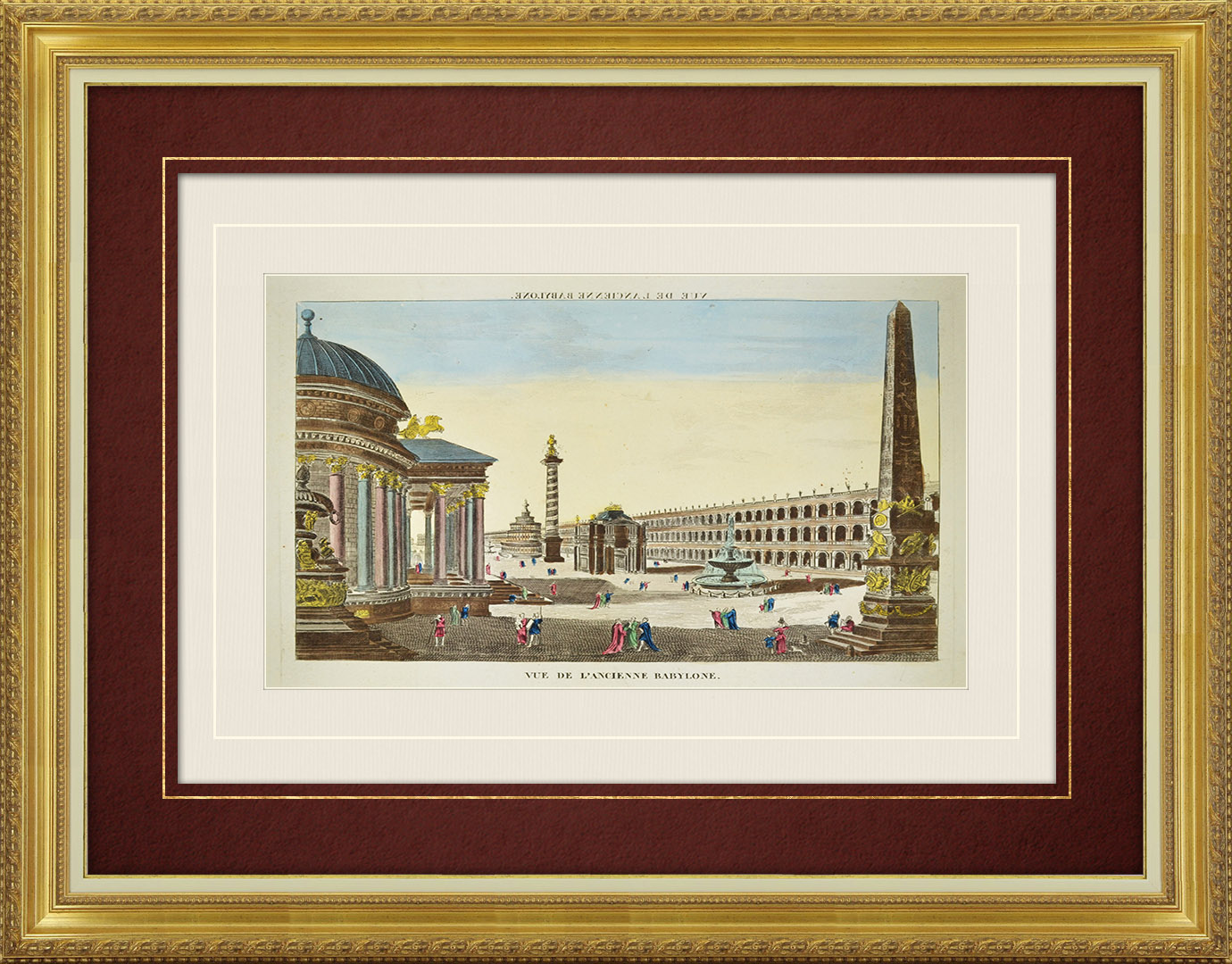
Original title
VUE DE L'ANCIENNE BABYLONE
Mentions
A Paris, chez HOCQUART, rue St. Jacques, 64.
Description
Early XIXth century optical view in original watercolors. Original copper plate engraving on laid paper with watermark heightened with watercolor at that time. Published by Hocquart in Paris circa 1830, depicting a view of Ancient Babylon (Iraq).
During the 18th Century, several renowned establishments in Paris, London (England), Augsburg (Germany) and Bassano (Italy) were specialized in the creation of these optical views. They could be viewed alone or through a zograscope, a wooden foot surmounted by a lens which enlarged the image and accentuated the perspective effect. They could also be placed in optical boxes, the spectator then looked inside the box through the lens. This distraction was greatly appreciated in the 18th Century in the salons of the bourgeoisie and the nobility as in the countryside thanks to the hawkers.
These etchings are nowadays exhibited in museums around the world and extremely appreciated by collectors and decorators for their historical interest and their high decorative value.
Condition report
Very good state
Find more artworks related to these topics :
This strong water etching is listed in these categories :
Babylon was the capital city of Babylonia, a kingdom in ancient Mesopotamia, between the 18th and 6th centuries BC. It was built along the left and right banks of the Euphrates river with steep embankments to contain the river's seasonal floods. Babylon was originally a small Akkadian town dating from the period of the Akkadian Empire c. 2300 BC.
The town became part of a small independent city-state with the rise of the First Babylonian dynasty in the 19th century BC. The Amorite king Hammurabi created a short-lived empire in the 18th century BC. He built Babylon into a major city and declared himself its king. Southern Mesopotamia became known as Babylonia and Babylon eclipsed Nippur as its holy city. The empire waned under Hammurabi's son Samsu-iluna and Babylon spent long periods under Assyrian, Kassite and Elamite domination. After being destroyed and then rebuilt by the Assyrians, Babylon became the capital of the short-lived Neo-Babylonian Empire from 609 to 539 BC. The Hanging Gardens of Babylon were one of the Seven Wonders of the Ancient World. After the fall of the Neo-Babylonian Empire, the city came under the rule of the Achaemenid, Seleucid, Parthian, Roman, and Sassanid empires.
It has been estimated that Babylon was the largest city in the world c. 1770 – c. 1670 BC, and again c. 612 – c. 320 BC. It was perhaps the first city to reach a population above 200,000. Estimates for the maximum extent of its area range from 890 to 900 hectares (2,200 acres).
The remains of the city are in present-day Hillah, Babil Governorate, Iraq, about 85 kilometres (53 mi) south of Baghdad
The Galerie Napoléon is pleased to propose to you this strong water etching printed 194 years ago (around 1830).
As for all the antique prints in our catalogue, this optical view VUE DE L'ANCIENNE BABYLONE datant de 1830 is dispatched worldwide within 24H in a Secured packaging, accompanied by its certificate of authenticity guaranteeing the name of the artists (draughtsman, engraver, editor), the impression process used (Strong water) and its date (1830).
In order to guarantee a perfect conservation in time, this strong water etching is dispatched, ready to be framed, under museum quality color passepartout (manufactured without acid in the pulp for a neutral pH) on a cream mountboard made from carton bois (also acid free & neutral pH), in a luxurious portfolio.
At the apogee of the mode for optical views, between 1750 and 1790, four European cities specialized in their edition: Paris (France), London (England), Augsburg (Germany) and Bassano (Italy).
Optical views are prized in very different social circles : pleasant recreation in aristocratic salons, the views are admired in beautiful and richly decorated optical boxes which are real works of art. The show was transformed into a real scientific experiment. But the optical views also entertained the people who were in a hurry when a hawker set up a box on a market and began to narrate the extraordinary events that had taken place in a more or less distant and inaccessible country.
There are three categories in the production of optical views.

With more than 20 years experience and a catalogue of more than 40.000 antique prints, drawings and historical documents dating from the 14th to the 19th century, the Galerie Napoléon, parisian antique dealer's gallery, is one of the world references in the field of antique prints,etchings and antique graphic arts.
In addition to thousands of impassioned of antique prints throughout the world, the Galerie Napoléon is honoured to count among its customers : national archives, museums, historical monuments and important home designer companies. All attracted by the extraordinary diversity of its catalogue and the quality and speed of its services.
This experience allows us to guarantee to each one of our customers the authenticity of the antiques in our catalogue and the shipment of their orders within 24 hours.

Customize for free the color of your museum quality bevel cut edge passepartout (acid free & neutral pH) among a color chart of 23 shades.
This option will be offered to you free of charge in the cart.
All our antiques can be shipped worldwide. The orders are dispatched within 24H in a secured packaging.
The Galerie Napoléon offers free shipping for all orders over 50EUR for France, 70EUR for all EU destinations and 90EUR for worldwide destinations.
For orders below these amounts, the shipping costs are 8EUR for France, 12EUR for all EU destinations and 17EUR for worldwide destinations.

























